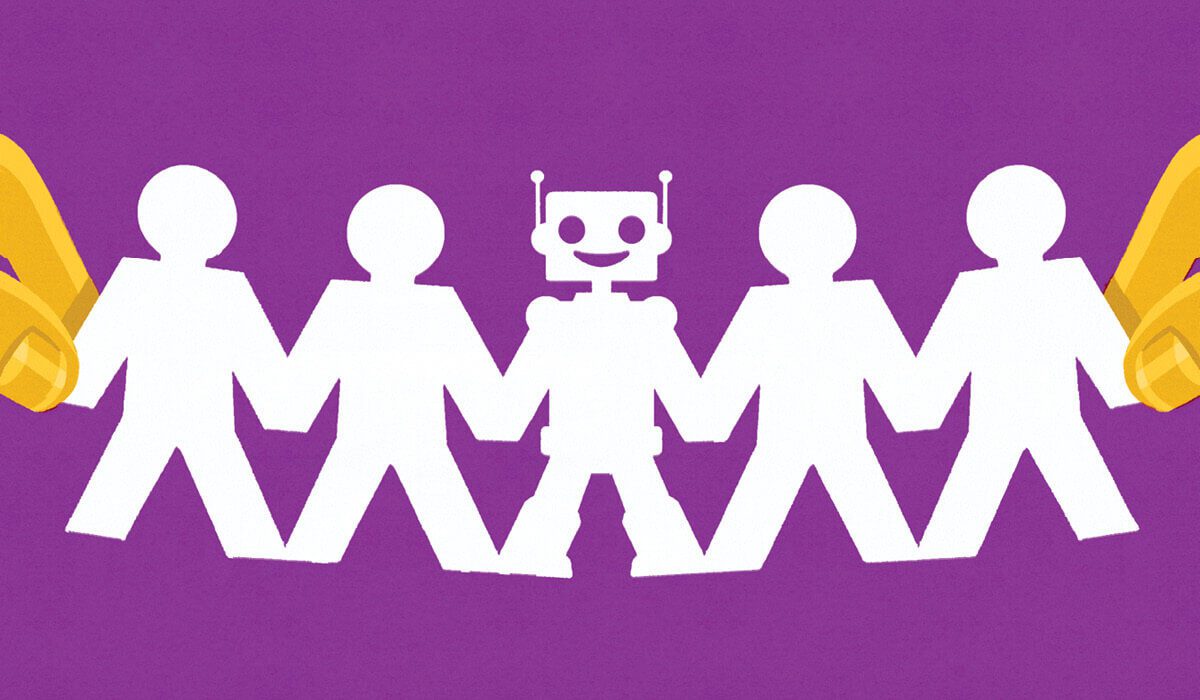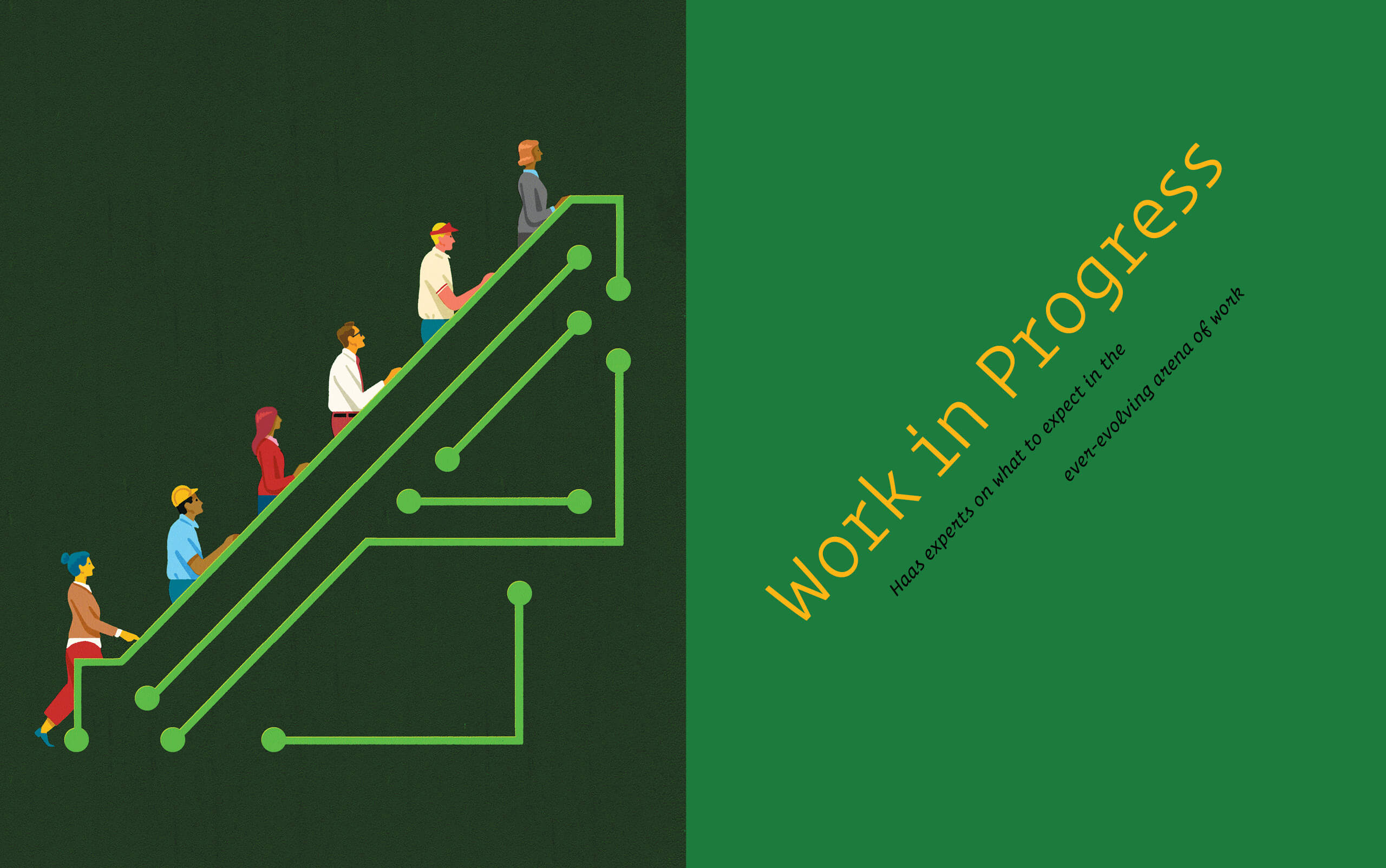Negotiating the Future
Change has long been coming for the world of work.
Automation and artificial intelligence technologies have been on the horizon or among us in their rudimentary forms for years—we’ve grown used to customer service conversations with chatbots, for example. Online hiring platforms (such as Upwork for freelance gig workers) have been complementing more traditional approaches to hiring for roughly a decade. And even pre-pandemic, the proportion of remote-capable U.S. workers in fully remote arrangements was inching up slowly, by 2019 climbing to 8%, according to Gallup.
COVID-19 kicked these slowly evolving trends into a turbo-charged rate of dizzying change. By mid-2022, nearly a third of remote-capable U.S. workers were fully remote. A survey by Upwork found that 53% of businesses said the pandemic increased their willingness to hire freelance gig workers. And the pandemic-induced imperatives to social distance and to adapt to fluctuations in demand spurred new investment in and utilization of automation technologies.
Several Haas thought leaders are focusing their research on the questions many of us are asking ourselves as we reel from the rapid changes imposed on our work lives and work identities. For whom is the shift to remote work a net-positive change, and for whom is it a detriment? In which situations might these newly pervasive work arrangements be narrowing inequalities among workers—and where are they creating new ones? What does the newest research suggest about the likelihood that cutting-edge AI tools will render obsolete whole sectors of workers? And, perhaps most importantly, how do we define “good jobs”—and how can we, as a society, ensure that they don’t go extinct?
The Haas thought leaders featured here don’t have all the answers, but they do have research-backed predictions, policy recommendations, and reasons for both concern and optimism as we chart our way through the end of work as we knew it—and orient ourselves in the world of work that’s emerging in its place.
The remote future
 Assistant Professor David Holtz signed the papers that made official his doctoral research internship at Microsoft in March 2020—timing that would prove portentous. He’d been invited into the technology firm’s Redmond, Washington, offices to study online marketplaces. Soon, however, Holtz found himself working not from Microsoft’s campus but remotely from his East Coast apartment—and on an altogether different research question: How was the swift decampment to remote work affecting communication and collaboration within Microsoft?
Assistant Professor David Holtz signed the papers that made official his doctoral research internship at Microsoft in March 2020—timing that would prove portentous. He’d been invited into the technology firm’s Redmond, Washington, offices to study online marketplaces. Soon, however, Holtz found himself working not from Microsoft’s campus but remotely from his East Coast apartment—and on an altogether different research question: How was the swift decampment to remote work affecting communication and collaboration within Microsoft?
Before the pandemic descended, 18% of Microsoft’s U.S. employees worked remotely. By April 2020, the firm had instituted a mandatory work-from-home policy for all of its non-essential U.S. employees.
To investigate how remote work reshaped communication practices among Microsoft’s more than 60,000 U.S.-based employees, Holtz and his co-authors analyzed anonymized data summarizing individual workers’ time spent in meetings and on calls, the number of emails and instant messages they sent, the length of their workweeks, and the patterns of their collaboration networks.
Their data covered December 2019 to June 2020—so, the several months before and after the firm-wide work-from-home policy took effect. Access to this before-and-after data was important, Holtz emphasizes, because it allowed the research team to compare the working patterns of those 18% of employees who’d been remote pre-pandemic to the patterns of those who shifted to remote work because of COVID-19.
“We took really seriously the matter of trying to separate the effects of remote work from the effects of the pandemic,” Holtz explains. Already in 2020, many were speculating that a wholesale return to offices might never happen. “We wanted to understand, if that were the case, what would the effects of remote work be once the pandemic had subsided?”
Overall, the picture of remote work that emerged in their findings was not one of an arrangement particularly conducive to innovation. One of their main findings was that working remotely was associated with a decrease in the number of (and amount of interactions with) a person’s “weak ties”—that is, those colleagues with whom you don’t work directly but with whom a casual interaction can prove helpful or illuminating in surprising ways.
“There’s all this research that shows weak ties to be really important for the diffusion of new ideas and the propagation of information through an organization,” Holtz says.
Relatedly, they found that the rate of change within employees’ networks fell considerably when working remotely. “The network kind of ossifies and starts to freeze in place,” Holtz says. “Research shows that creativity is associated with fresh teams, working with new folks.”
Inequalities, old and new
 Research from Associate Professor Aruna Ranganathan adds a more positive dimension to this picture of remote work’s effects—especially when it comes to creativity. For some individuals within an organization, her research suggests, the adoption of a remote setup may actually act as a booster shot for creativity and performance.
Research from Associate Professor Aruna Ranganathan adds a more positive dimension to this picture of remote work’s effects—especially when it comes to creativity. For some individuals within an organization, her research suggests, the adoption of a remote setup may actually act as a booster shot for creativity and performance.
Ranganathan has always been a scholar of work and employment, with a particular focus on individual-worker outcomes. “I’m interested in understanding how remote work perhaps exacerbates some preexisting inequalities, creates new forms of inequality, and also has the potential to mitigate some inequalities that existed in more traditional forms of work,” she says. She points to research indicating that women have long been held back from performing to their full potential at work, given that they experience more interruptions in team discussions and generally face lower performance expectations. Of course, this previous research has presumed a traditional synchronous team environment (imagine employees chatting in real time around a conference table). But as many of the world’s workers moved remote during the pandemic, asynchronous collaboration (via email, say) shot up.
For some individuals within an organization … the adoption of a remote setup may actually act as a booster shot for creativity and performance.
In one project, Ranganathan and her co-author studied folk music ensembles (consisting of a singer and a few instrumentalists) in eastern India performing traditional songs, each having many versions and interpretations largely determined by the singers. In these groups, gender roles are prescribed. When women are members, they typically only sing. Because each ensemble member has a distinct role, songs can be recorded either live as a group or solo and later combined digitally.
Ranganathan and her co-author found that working alone afforded women singers greater freedom of creative expression than when working within a group of men in a more traditional synchronous environment. But tempting as it may be to conclude that remote work is the magic salve in addressing the problem of unequal treatment in the workplace, Ranganathan cautions against it.
“If we just embrace remote work, we’re not solving the root problem, which is that when these teams come together, certain members are not making other members feel included,” she says. “Embracing remote work shouldn’t mean we don’t try to continue also reshaping the synchronous work environment to be more inclusive of women and other minorities in the workplace.”
Protecting workers
Distinguished Professor Laura Tyson, who has written extensively about the future of work, technology, and trade policy (and who formerly served as an advisor to President Clinton), looks further ahead as she considers the disrupting force of technology on workers. In particular, her books, columns, and papers have lately focused on automation and AI and whether “good jobs” will be able to proliferate as these technologies—which perform tasks more cheaply, faster, and often better than humans—assert greater influence.
Her prognosis is not hopeful for those blue-collar jobs one might reasonably consider “good”—that is, those that offer middle-class incomes, safe conditions, legal protections, career advancement, and benefits. She’s written that she fears any economic growth spurred by advancing AI technologies will not be widely shared and will further fuel economic inequality.
“AI will automate many tasks, change existing tasks, and create new ones. There will be both winners and losers in this process,” she wrote in her recent article, “Automation, AI & Work.”
Firms investing more in AI were also the ones with higher employment rates. … When firms adopt AI technologies, it actually creates the need for new types of human expertise.
Tyson says diverse communities across the U.S. will need to devise “tailored strategies” to meet the changes wrought by technologies still on the horizon. For instance, she points to the need for more affordable housing in major cities and better digital infrastructure to support remote work in rural areas. “All communities can expect to face challenges relating to workforce redeployment and mobility, skills and training, economic development and job creation, and support for those undergoing occupational transitions triggered by automation.”

Research from Assistant Professor Anastassia Fedyk offers some optimism on how AI could enhance employment in some areas. In one study, Fedyk found that the firms investing more in AI were also the ones with higher employment rates. She says this suggests that when firms adopt AI technologies, it actually creates the need for new types of human expertise.
“What the data show is that the main effect of AI in most industries is not replacing human labor,” she says. “Instead, AI is allowing firms to innovate and grow.”
Where her findings align with Tyson’s concern is on the topic of inequality. Fedyk’s other research has found that firms investing more in AI go on to hire more-educated workforces. “It seems that firm investments in AI are conducive to greater demand for college-educated and technical workers,” she says. “These findings suggest that it’s important to invest in upskilling the workforce as firms adopt new technologies such as AI.”
Investing in education
Haas Dean Ann Harrison places similar emphasis on the importance of schooling and worker training in countering inequality as the nature of work transforms. One of the leading scholars in trade and development economics, Harrison points to educational programs as one of the most important public provisions in countering inequality.
“A school like UC Berkeley, and all of California’s public universities and community colleges, play a key role in leveling the playing field,” Harrison says. “But we could do even more. What scares me most is that significantly less than half of our young people get a four-year college degree—we need to change that by increasing public educational opportunities and scholarships.”
It’s not too late for policies written by humans, for humans, to help determine the ways in which rapidly advancing technologies will shape workers’ lives.
Harrison also says increased social protections need to be considered as well as incentivizing firms and innovators to grow in ways that employ more of America’s labor force. “In other words,” she says, “we need to encourage labor-using innovation and entrepreneurship.”
Indeed, worker training is one of the policy interventions Tyson emphasizes, too. She also recommends tax policy reforms to lower payroll and other payroll-related taxes, increasing social benefits and protections for gig workers, and introducing measures to enshrine workers’ ability to collectively bargain and unionize.
The upshot? Harrison and Tyson agree that it’s not too late for policies written by humans, for humans, to help determine the ways in which rapidly advancing technologies will shape workers’ lives.
“How the benefits of automation are shared among workers from a diverse array of backgrounds is not technologically predetermined,” Tyson has written. “It is entirely up to us.”
In fact, it’s even possible that AI tools can help clarify some of the most human parts of our work lives—such as allowing for a deeper understanding of how people are experiencing organizational life. Haas professors Jennifer Chatman and Sameer Srivastava developed a machine-learning method to integrate data from an employee survey with eight years of emails from a mid-size technology firm, giving a longitudinal look at “culture fit”—and how it’s formed and maintained within workplaces.
The results gave them valuable insight into what draws people to certain workplaces and sours them on others. “We found that two types of culture fit really mattered,” Chatman says. One type was “value congruence”—that is, the alignment between an employee’s personal values and the dominant ones within their organization—and the other was “perceptual congruence”—the extent to which an employee accurately perceives a workplace’s culture and behaves in accordance with it. These two distinct types of culture fit impacted different outcomes at work: Value congruence predicted how long people stayed with the organization, and perceptual congruence was closely tied to workers’ performance success.
As the workplace and the nature of work itself continue to transform in ways both predictable and less so, understanding workers’ motivations and the drivers of their performance will only grow more important. After all, for the time being at least, humans are still the most complicated machines keeping the world of work running.
Posted in:
Topics:




